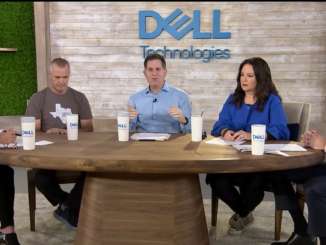
As enterprises continue to spread their workloads around – keeping some in their core datacenters while placing others in either private clouds or sprinkling them among disparate public clouds – the portability, visibility and management of those applications becomes an issue. There is no standardization among public cloud providers like Amazon Web Services (AWS), Microsoft Azure and Google Cloud Platform, among others, and applications that run well in an on-premises datacenter may hit some rough patches when they migrate to the cloud. Developers also are finding challenges when moving applications into production, either in the datacenter or cloud, also come with their share of challenges.
The rise of microservices and containers has given enterprises a way of making these applications easier to move between the datacenter and the cloud, or between various cloud environments, by encapsulating them with their requirements to give them easier portability. A number of orchestration technologies, such as Docker Swarm and Red Hat’s OpenShift, were released to more easily manage containers when they’re on the move, though Kubernetes has become the dominant orchestration tool.
“Many of our customers are either using or experimenting with it in dev and test scenarios,” Kurt Milne, product marketing manager for Cisco Systems’ CloudCenter line, tells The Next Platform. “Now we’re seeing customers are increasingly trying to use it in production as well. This is forcing operations teams to actively evaluate changing the tools and processes they use to manage IT, from VM-centric to more container-optimized operations.”
Multicloud has become a key component of Cisco’s strategies moving forward. Enterprises will continue to leverage more than one public cloud for a variety of reasons. For example, certain workloads may run better on one cloud over another, and organizations also may be reluctant to put all their applications and data into one cloud for fear of what would happen if that cloud went down. A key part of the vendor’s multicloud initiative is helping enterprises to not only adopt such a strategy, but also to securely move and manage the applications. Containers and Kubernetes are playing an increasingly large role in that strategy.
Cisco and Google – the creator of Kubernetes – last fall announced a plan to jointly develop a hybrid cloud solution designed to help companies more easily deploy, monitor and manage their applications and services from the datacenter to the public clouds and to move them between the environments. The plan for the solution, which is due out later this year, includes using Kubernetes and Istio, an open platform created by Google and others for managing and securing microservices, while leveraging such Cisco products as its Hyperflex converged infrastructure solution as a cloud-ready platform for containers and Kubernetes as well as Cisco’s Private Cloud Infrastructure. Google also is putting it in the Google Kubernetes Engine (GKE).
Earlier this year, Cisco rolled out the latest version of the software for HyperFlex that includes container support, and a week later unveiled the Cisco Container Platform, a software offering based on upstream Kubernetes. Cisco also has been active in the development of Kubernetes and related open-source ecosystem projects, including Istio, Contiv, FD.io, and Kubeflow, according to Milne. In its latest step, Cisco says that its AppDynamics and CloudCenter software will now support Kubernetes, which is designed to enable enterprises to easily deploy and monitor Kubernetes-based containerized applications both on-premises and public cloud environments. CloudCenter is based on technology Cisco inherited in its $260 million acquisition of CliQr two years ago that is aimed at managing applications in multicloud and multi-datacenter environments. AppDynamics – Cisco bought the company of the same name in 2017 for $3.7 billion – for application performance monitoring and management.
AppDynamics for Kubernetes, which will be available May 9, will offer performance metrics on not only the application, but also one Kubernetes and Docker containers. Included in the new version of AppDynamics is the AppDynamics Business Transaction, which is made up of services like login, search and checkout that are needed to respond to a user-initiated request. Root cause analysis is speeded up through the use of machine learning techniques. Through CloudCenter 4.9, which is available now, enterprises can deploy containerized workloads to a Kubernetes cluster regardless of location, and by auto-generating the pod manifest file (YAML) that is specific to each deployment, containerized workloads can easily move between public clouds rather than getting locked into a single one. It also means that developers who don’t want to learn kubectl commands can still leverage Kubernetes.
“A bedrock principle of containers and platforms like Kubernetes is portability,” Cisco’s Milne says. “Especially in the enterprise, you will find workloads being optimized to different datacenter and cloud locations over time. The ability to move the immutable images from private to public clouds, or even one public cloud provider to another, gives enterprises confidence as they adopt a cloud strategy and the ability to optimize their deployments over time for cost, compliance, and administrative control. However, when containers are deployed in a Kubernetes environment, storage drivers, network and security settings and many things developers are concerned about are codified in the Kubernetes pod mainfest file. Those parameters and developer concerns can be environment-specific; for example, persistent storage on distributed and software-defined storage on Hyperflex versus network-attached storage in another datacenter versus storage in the cloud. Cisco’s multicloud solution strategy guides our solution development efforts to keep containerized workloads from getting locked into a single Kubernetes environment.”
It’s not surprising that the market has gravitated toward Kubernetes for container orchestration.
“Kubernetes was developed and released to Cloud Native Computing Foundation by Google just over two years ago and now has more than 1,600 contributors to its codebase, providing businesses with tremendous innovation leverage,” Milne says. “When it comes to containers and Kubernetes, it’s all about agility and choice. This has spawned the availability of a number of vendors’ Kubernetes platform solutions catering to various developer requirements and use cases. Recognizing these varied requirements, Cisco enables its customers with a number of these leading Kubernetes-based solutions, one of which being its own Cisco Container Platform, a Kubernetes platform providing users with direct access to native upstream Kubernetes, and integrations with Cisco and third-party tools addressing security, network management and governance.”





As your sister site has said, AWS Lambda has won the battle. OS don’t matter any more. If this Lambda code can be packaged, delivered, deployed in a stackless way (where everything can be orchestrated during execution time), computing will be changed for ever. People writing code for servers will not write applications any more. Just functions. Whoever gets there first is going to clean house.